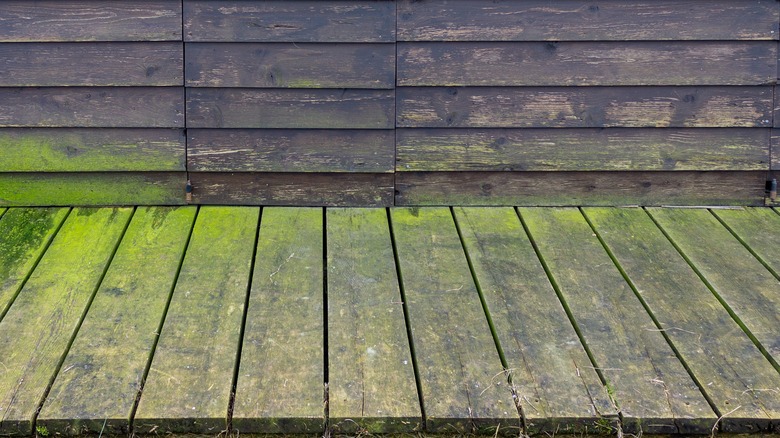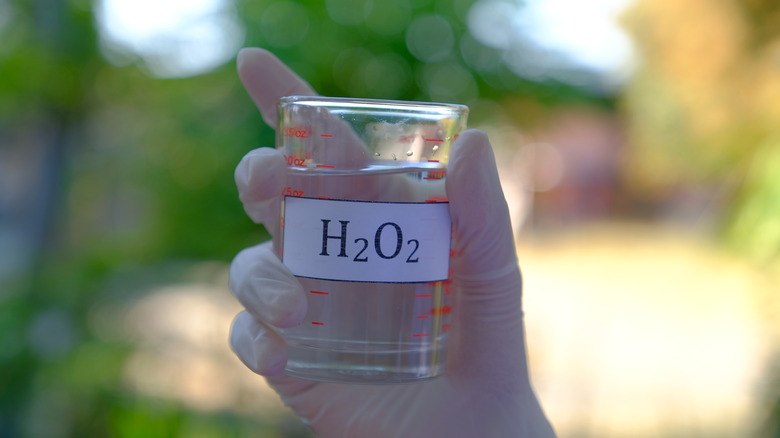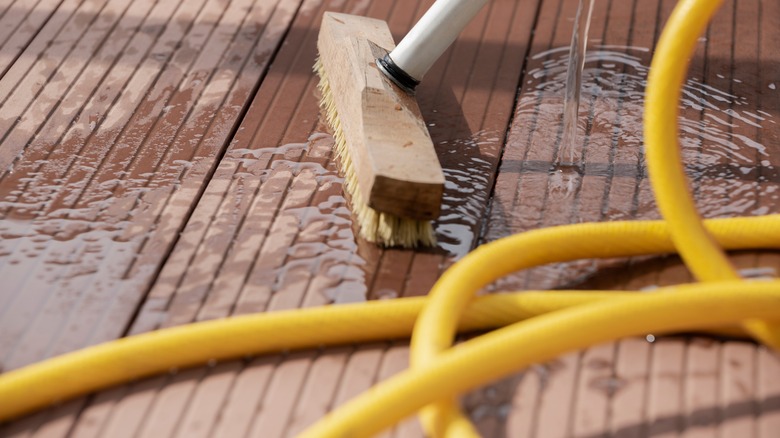Keep Your Wood Deck Or Patio Grime-Free With A Household Staple
Do you find yourself frequently slipping on the deck after it rains? If the slippery areas look like they're covered in a green grime, you're looking at algae, which is the culprit behind the slippery deck surface. Discovering algae on the deck is concerning, since without prompt treatment it can cause several issues apart from creating a fall hazard. Crucially, algae retains water, and the latter penetrates deep into wooden deck boards, damaging the wood core over time. Also, algae spreads quickly if you leave it unchecked, so you may find that a small spot quickly grows and overwhelms the entire patio. Now, you can't just use any cleaner to treat this problem. In fact, some cleaners like bleach should never be used on wooden decks. But the good news is that removing algae from the boards doesn't require special cleaners or professional help. You can do it yourself using hydrogen peroxide and a stiff bristle brush.
Hydrogen peroxide is a corrosive oxidizing compound that kills organisms it comes in contact with. Studies have shown that adding hydrogen peroxide to algae-infested water in sufficient concentrations can kill the growth. When you apply it to your deck, you'll see evidence of this eradication as the peroxide foams up on contact with algae-affected spots. Below, you'll learn how this technique works, precautions you should take while handling hydrogen peroxide, and ways to prevent algae spots from returning in the future.
How to clean grime off your deck with hydrogen peroxide
Before you start cleaning, make sure you've got the proper protective and cleaning equipment. The hydrogen peroxide you'll use — the store-bought variety with a 3 to 5% concentration — is a mild irritant for the skin and eyes. Since you'll handle this chemical with your hands and the brushing may cause it to splash, it's best to wear gloves and safety goggles before proceeding. You'll also need a bucket for discarding cleaning waste (dumping it in the yard can damage your grass), and some water to wash unprotected parts of your skin if the peroxide gets on it. Next, find a stiff-bristled brush to scrub the deck boards. If you'd rather not spend an hour cleaning on your knees, opt for a stiff-bristled broom instead of a brush. As for the peroxide itself, the right quantity will depend on the size of the deck, but it pays to have at least three to four bottles handy.
Now, clear the deck of all items, and sweep it with a broom to remove debris. Then, pour a bit of the peroxide onto the boards, and scrub the area thoroughly with the brush or broom. You'll see the peroxide bubbling as it produces gas, which means that it's eradicating the organisms it's coming in contact with. You can scrape the foam off and discard it in a bucket. Repeat the procedure until the grime-affected areas are treated, then rinse the deck with a hose.
How to prevent grime on your wooden patio or deck
The procedure described above is a surefire way to oust algae from your deck. But unless you want to regularly spend an hour or two scrubbing the boards with peroxide, you should take steps to avert algae growth in the first place. Doing so isn't difficult; you just have to prevent algae's ideal growing conditions from appearing on the deck.
Algae flourishes in areas where there's ample moisture and shade. Make an effort to prevent standing water on the patio or deck on rainy days to deny algae the moisture it needs to thrive. Likewise, clear any debris that may contribute to a dark environment on the deck. This could include leaves or items you may be storing on the deck that cast a shadow and encourage the algae to develop. It's possible that the deck is naturally located in a shady area, and the house or the surrounding trees are responsible for shaded patches you can't do much about. In this case, do your best to keep the deck dry, and deep-clean the boards with peroxide as soon as traces of grime show up. Prompt cleaning should keep the grime from spreading over time. Does your deck suffer from moss infestations, too? Then be sure to clean the moss off with household ingredients like baking soda and vinegar.


